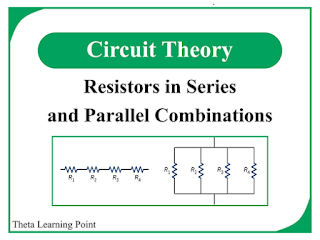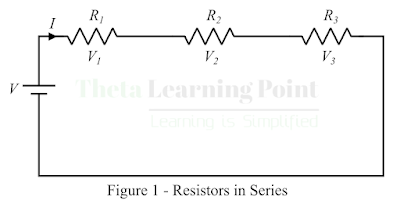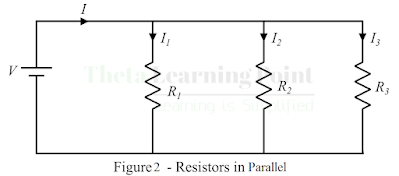In an electrical or electronic circuit, we combine resistors
in the following two ways to achieve the desired value of resistance-
- Series connection of resistors
- Parallel connection of resistors
Series Combination of Resistors
In a circuit, when resistors are connected end to end so
that there is only one path for electric current to flow is called a series combination of resistors.
Consider a circuit as shown in figure-1 having three
resistors R1, R2,
and R3 are joined end to
end, i.e. the ending terminal of the first resistor is connected to the starting
terminal of the second resistor, and the ending terminal of the second resistor
to the starting end of the third resistor, so that current flowing through all
the resistors is the same.
According to Ohm’s law, the voltage across various resistors is given by,
`\V_1=IR_1`
`\V_2=IR_2`
`\V_3=IR_3`
If V
is the total voltage across the series combination of resistors, then we have,
`\V=V_1+V_2+V_3`
`\⟹V=IR_1+IR_2+IR_3`
`\⟹V=I(R_1+R_2+R_3 )`
`\V/I=R_1+R_2+R_3`
But, V/I
is the total resistance of the series combination of resistors, i.e.
`\R_t=V/I`
`\∴R_t=R_1+R_2+R_3" "…(1)`
Hence, from equation (1), it is clear
that when a number of resistors are
connected in series, the total resistance of the combination is equal to the
sum of the resistance of the individual resistors.
If we have an electric circuit consisting
of N resistors connected in series,
then the total resistance of the circuit is given by,
`\∴R_t=R_1+R_2+R_3+⋯+R_N" "…(2)`
Consider a special case, where a circuit
consists of N resistors having equal
values of resistance (say R), and are
connected in series, then the total resistance of the combination is given by,
`\R_t=R+R+R+⋯"till "N`
`\∴R_t=NR" "…(3)`
Hence, when a number of resistors of
equal resistance value are connected in series, the total resistance of the
combination is equal to the product of the number of resistors and the
resistance of any one of the resistors.
Parallel Combination of Resistors
When one end of each resistor is
connected to a common point and the other end of each resistor is connected to
another common point so that the number of paths for current to flow is equal to
the number of resistors, then it is called a parallel combination of resistors.
Here, the voltage across each resistor is
the same, i.e. V, but the total
current I divides into three parts,
i.e. I1 through the
resistor R1, I2 through the resistor R2, and I3 through the resistor R3. Hence, it is clear that in a parallel combination of
resistors, there are as many current paths as the number of resistors.
According to Ohm’s law, the current flowing
through each resistor is given by,
`\I_1=V/R_1`
`\I_2=V/R_2`
`\I_3=V/R_3`
Also, the total current I is given by,
`\I=I_1+I_2+I_3`
`\⟹I=V/R_1 +V/R_2 +V/R_3`
`\⟹I=V(1/R_1 +1/R_2 +1/R_3)`
`\⟹I/V=1/R_1 +1/R_2 +1/R_3`
But, V/I
is the total resistance Rt
of the combination.
`\∴1/R_t =I/V`
Therefore,
`\1/R_t =1/R_1 +1/R_2 +1/R_3" "…(4)`
Hence, when a number of resistors are connected in parallel, then the
reciprocal of total resistance is equal to the sum of the reciprocals of the
individual resistors.
Case
1 – Two Resistors in Parallel:
Hence, the total resistance of two
resistors in parallel is equal to the product divided by the sum of the resistances
of the two resistors.
Case
2 – N Resistors of Equal Resistance
in Parallel:
When N
resistors of equal resistance (say R)
are connected in parallel, the total resistance of the combination is given by,
`\R_t=R/N`
Numerical
Example – Find the total resistance of the
circuit shown in figure-4.
Step
1: Resistance between points b and c:
`\R_(bc)=(2×3)/(2+3)=1.2 Ω`
Step
2: Resistance between points e and d:
`\R_(ed)=(3×5)/(3+5)=1.875 Ω`
Step
3: Resistance between points a
and e, which is the total resistance
of the network:
`\R_t=5+1.2+6+1.875`
`\∴R_t=14.075 Ω`
Conclusion
Thus, in this article, we discussed series
and parallel combinations of resistors. From the above discussion, we can conclude
that when a number of resistors are connected in series, then the total
resistance of the combination is given by the sum of resistances of the
individual resistors. The total resistance of the series combination is greater
than the largest of the resistances.
When a number of resistors are connected in parallel, then the reciprocal of the total resistance of the combination is equal to the sum of reciprocals of resistances of the individual resistors. Also, the total resistance of the parallel combination of resistors is less than the smallest of the resistors.






.png)





0 Comments